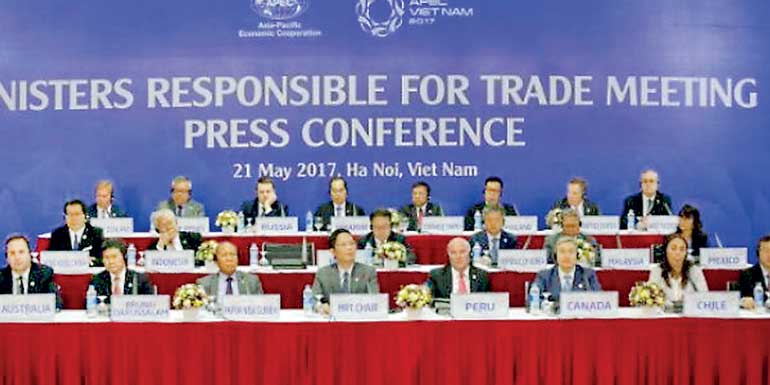Friday Mar 07, 2025
Friday Mar 07, 2025
Thursday, 1 June 2017 00:00 - - {{hitsCtrl.values.hits}}
 The remaining 11 countries in the TPP are currently exploring options to move ahead without U.S. | Photo: Reuters
The remaining 11 countries in the TPP are currently exploring options to move ahead without U.S. | Photo: Reuters
Reuters: The United States ruled out returning to the Trans-Pacific Partnership trade deal and said on it only wanted bilateral agreements in Asia, as Japan and other members agreed to more talks on pressing ahead themselves.
Turmoil over global trade negotiations was laid bare at a meeting of Asia-Pacific Cooperation (APEC) countries, which failed to agree the usual joint statement after US opposition to wording on free trade and fighting protectionism.
The meeting in Hanoi, Vietnam, was the biggest global trade gathering since US President Donald Trump upended the old order with his “America First” trade policy, designed to protect American jobs.
Trump withdrew from TPP in one of his first acts in office, but the 11 remaining countries agreed in Hanoi to explore how they could still move ahead - partly in the hope that the United States would reconsider leaving.
New U.S. Trade Representative Robert Lighthizer said there was no way back.
“TPP-11 can make their own decisions and the United States makes its decision, but we expect to stay engaged and I believe at some point there will be a series of bilateral agreements with partners in this part of the world,” he told a news conference.
Although the TPP members kept the trade agreement alive, they fell short of a wholehearted commitment to move ahead immediately with a deal that members also see as a way to contain an increasingly dominant China.
“Eleven countries have shown a lot of unity and a desire to move through some of the equations that will be required to look to put the agreement into force,” New Zealand Trade Minister Todd McClay, leading the discussions, told Reuters.
One of the biggest challenges is keeping on board Vietnam and Malaysia, which signed up for the deal and promised to make major reforms largely to get better U.S. market access. They now want to renegotiate some points.
The volume of trade between the remaining countries is barely a quarter of the level it would have been if the United States had remained in the TPP.
Officials from TPP countries will meet again in Japan in July and bring proposals in November, McClay said.
Protectionism
Fears of protectionism have grown under the Trump presidency and the gathering in Hanoi did nothing to quell them.
The Asia-Pacific countries failed to agree on their usual joint statement after the United States opposed wording that supported free trade and opposed protectionism, officials at the meetings said.
Instead, there was a statement from the Vietnamese chairman of the talks which gave a “commitment to promote trade and investment liberalization” but did not mention free trade or fighting protectionism as the grouping has in the past.
A separate statement from all members on actions to follow up after the summit did not contain such commitments either.
The wrangling is similar to what has been seen at gatherings of Group of 20 and Group of Seven financial leaders, where statements were toned down to fit with the new US agenda.
Explaining US opposition to using the word protectionism, Lighthizer said the term was being confused with the steps that were really need to lead to free trade.
“Our view is that we want free trade, we want fair trade, we want a system that leads to greater market efficiency throughout the world,” he said.
On the sidelines of the APEC meeting, Lighthizer held a series of one-on-one meetings with key partners, reflecting the push for bilateral deals.
China, putting itself forward as a global free trade champion in light of the US shift, is pushing a free trade agreement to encompass the vast majority of Asian economies. The Asia trade deal it favours is called the Regional Comprehensive Economic Partnership.
That trade deal covers only Asian countries, not the United States. It is not as exhaustive as the TPP deal and doesn’t have its strong protections for intellectual property or for labour rights and the environment.
Discover Kapruka, the leading online shopping platform in Sri Lanka, where you can conveniently send Gifts and Flowers to your loved ones for any event including Valentine ’s Day. Explore a wide range of popular Shopping Categories on Kapruka, including Toys, Groceries, Electronics, Birthday Cakes, Fruits, Chocolates, Flower Bouquets, Clothing, Watches, Lingerie, Gift Sets and Jewellery. Also if you’re interested in selling with Kapruka, Partner Central by Kapruka is the best solution to start with. Moreover, through Kapruka Global Shop, you can also enjoy the convenience of purchasing products from renowned platforms like Amazon and eBay and have them delivered to Sri Lanka.
Discover Kapruka, the leading online shopping platform in Sri Lanka, where you can conveniently send Gifts and Flowers to your loved ones for any event including Valentine ’s Day. Explore a wide range of popular Shopping Categories on Kapruka, including Toys, Groceries, Electronics, Birthday Cakes, Fruits, Chocolates, Flower Bouquets, Clothing, Watches, Lingerie, Gift Sets and Jewellery. Also if you’re interested in selling with Kapruka, Partner Central by Kapruka is the best solution to start with. Moreover, through Kapruka Global Shop, you can also enjoy the convenience of purchasing products from renowned platforms like Amazon and eBay and have them delivered to Sri Lanka.